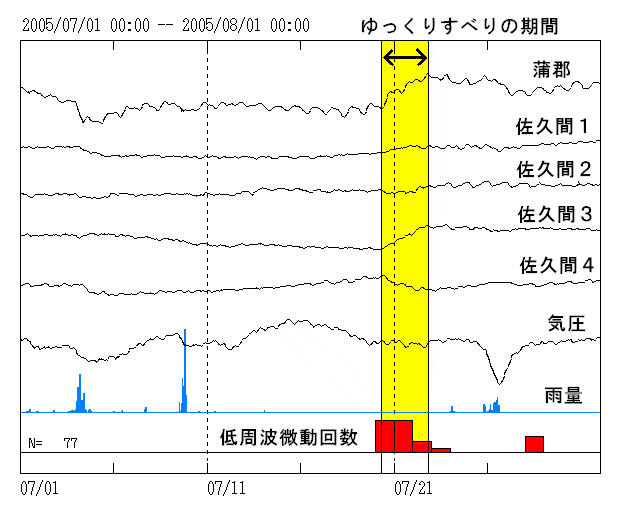この論文で2008年度地震学会論文賞をいただきました。東海地震を予知するためには、「東海地震に先行して前兆すべりが、ある程度の時間的余裕を持って発生すること」と、その「前兆すべりによる地殻変動を歪計が観測できること」が必要な条件ですが、未だ前兆すべりの観測事例はなく、東海地域の観測網でどれだけのことができるかは未知数でした。今回、深部低周波地震・微動と同時に発生しているとみられるプレート間すべりによる地殻変動を歪計で観測でき、その変化パターンにより変動源の推定ができる可能性を示せたことで、後者については明るい材料になったと思います。
要旨
2005年7月に一時的な歪変化が東海地域の歪計により観測された.同時期には愛知県で活発な低周波地震が発生していた.観測された歪変化は,短期的なスロースリップイベントに伴うものと考えられる.過去の歪計記録を調査したところ,約6年間に20回の同様な歪変化が見つかり,いずれも低周波地震を伴っていた.歪の変化パターンは3つ存在し,低周波地震の発生領域は各パターンで異なっていた.それぞれの低周波地震の震央付近のプレート境界上でのすべりを考えることで,それらの歪変化の特徴は説明できる.また1984年以降の歪計記録を調査したところ,短期的スロースリップに伴うと思われる歪変化は,過去からほぼ定常的に発生していた.
A short-term slow slip event (SSE) synchronizing with an activity of low frequency earthquakes occurred in Aichi prefecture on July 20-22, 2005. Characteristic strain changes caused by the short-term SSE were recorded by the strainmeters of Japan Meteorological Agency. We examined in detail whether or not strain changes were observed in the data of the Tokai area since July, 1984. As a result, eleven strain changes were detected in about fifteen years from July, 1984 to August, 1999, during which only the data of volumetric strainmeters were available. Twenty strain changes were detected in six years from September, 1999 to August, 2005, during which the data of multi-component strainmeters and information of low frequency earthquakes were also available. Those strain changes thus detected were classified into three types. The three types were corresponding to different active areas of low frequency earthquakes. The three patterns of the observed stain changes were explained by assuming rectangular faults in the active areas of low frequency earthquakes. It was found that the short-term SSE occurred more frequently in the periods of 1987-1989 and 2003-2004. These active periods roughly agree with that of the long-term SSE in the Tokai region.

図 短期的ゆっくりすべりによるひずみ変化の例(2005年7月)
|
